Expressive Structure
Learning Objectives:
- Describe the structural systems in the following portfolio of recently completed cultural buildings.
- Discuss strategies for integrating mechanical systems into these expressive structures in ways that are unobtrusive and operationally efficient.
- Discuss the engineering, formwork, and concrete-placement challenges presented by the buildings in this collection made of reinforced concrete.
- For those projects located in seismically active zones, describe the features intended to limit earthquake damage.
Credits:
This course is approved as a Structured Course
This course can be self-reported to the AANB, as per their CE Guidelines
Approved for structured learning
Approved for Core Learning
This course can be self-reported to the NLAA
Course may qualify for Learning Hours with NWTAA
Course eligible for OAA Learning Hours
This course is approved as a core course
This course can be self-reported for Learning Units to the Architectural Institute of British Columbia
View course on architecturalrecord.com »
Expressive structure makes a gallery, a performing-arts center, and two new museums stand out. This section highlights extraordinary construction and engineering achievements.
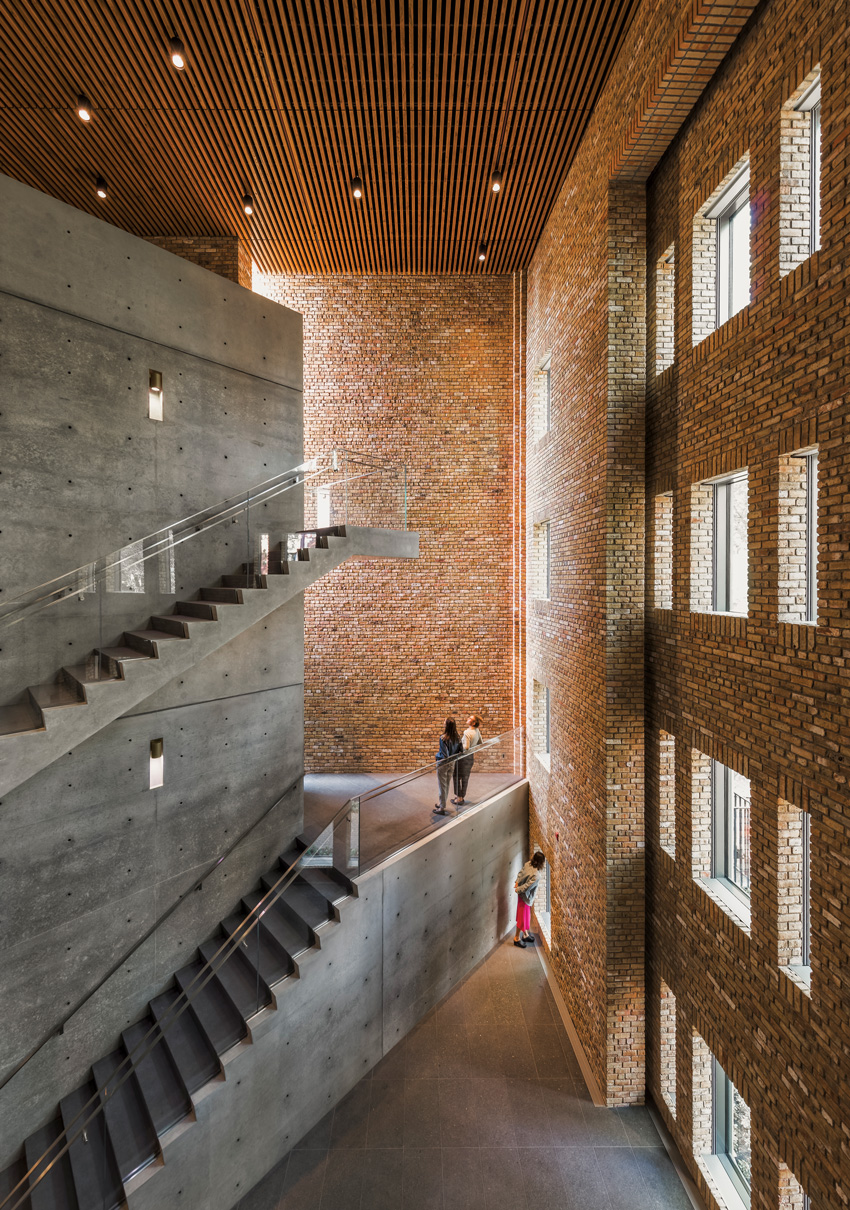
PHOTOGRAPHY: © JEFF GOLDBERG
WRIGHTWOOD 659, CHICAGO, TADAO ANDO
Making Waves
Artificial hills are alive with the sound of music at this performing-arts center.
National Kaohsiung Center for the Arts | Taiwan | Mecanoo
By Clifford A. Pearson
Part landscape, part architecture, the 1.51 million-square-foot National Kaohsiung Center for the Arts tucks a collection of performance halls beneath a 35-acre artificial terrain that rolls like hills. Floating at one end of a park that had been a military base, the $366 million complex—the largest performing-arts center under one roof—seems to ooze from below its immense lid, blurring the boundaries between indoors and out, solid and void. The Dutch architecture firm Mecanoo created an undulating middle realm between roof and ground that provides access to four indoor auditoria while remaining open to breezes and views of the park on all sides. Inspired by the large banyan trees that grow on the site and provide welcome shade, with their long, arching branches, the architects enveloped this interstitial space in a curving steel canopy that slides down to wrap around the elliptically shaped theaters. Called Banyan Plaza, it provides a cool retreat from the subtropical sun and frequent rains—a place where anyone can come to do tai chi in the morning, jog in the afternoon, or watch films projected on its underside in the evening.
In Kaohsiung, a city near the southwest tip of Taiwan, night markets and street performances animate the public realm after dark, when temperatures drop. The architects hope their Banyan Plaza works in the same way, luring people to dance, sing, and sketch, while others come to attend ticketed events indoors. “We wanted to capture the city’s wonderful mix of informal and formal,” says Francine Houben, founding partner and creative director of Mecanoo.
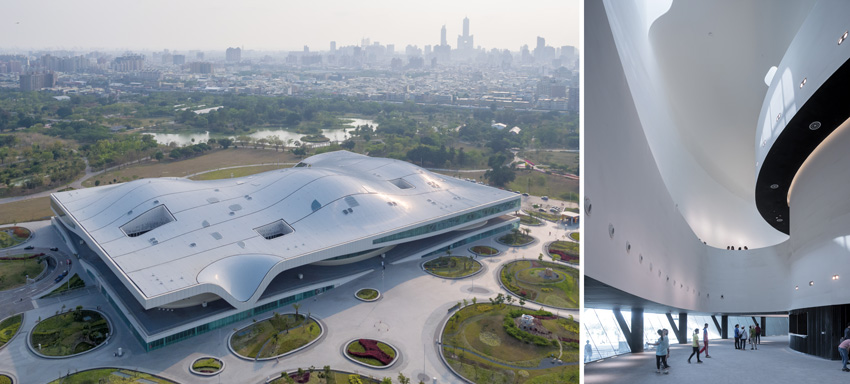
PHOTOGRAPHY: © IWAN BAAN
CURVE APPEAL
The bulbous roof covers 35 acres. Interior passages allow visitors to move from one venue to the next (right).
A built-up roof resting on a steel frame buffers the performance halls underneath from the sound of rain and outdoor noise while etching an eye-catching profile against the horizon and acting as the projects’ fifth facade. On one side, it dips down to touch the ground and form an outdoor amphitheater with stepped seating that allows visitors to climb this part of the building. The indoor venues range from a 2,236-seat opera house to a 1,981-seat concert hall, a 1,210-seat playhouse, and a 434-seat recital hall. People attending performances enter the individual halls from the public plaza and can also circulate from one venue to another on the third level, a fully enclosed floor that connects all of the auditoria, offering spaces such as bars, cafés, and lobbies where audiences can relax during intermissions.
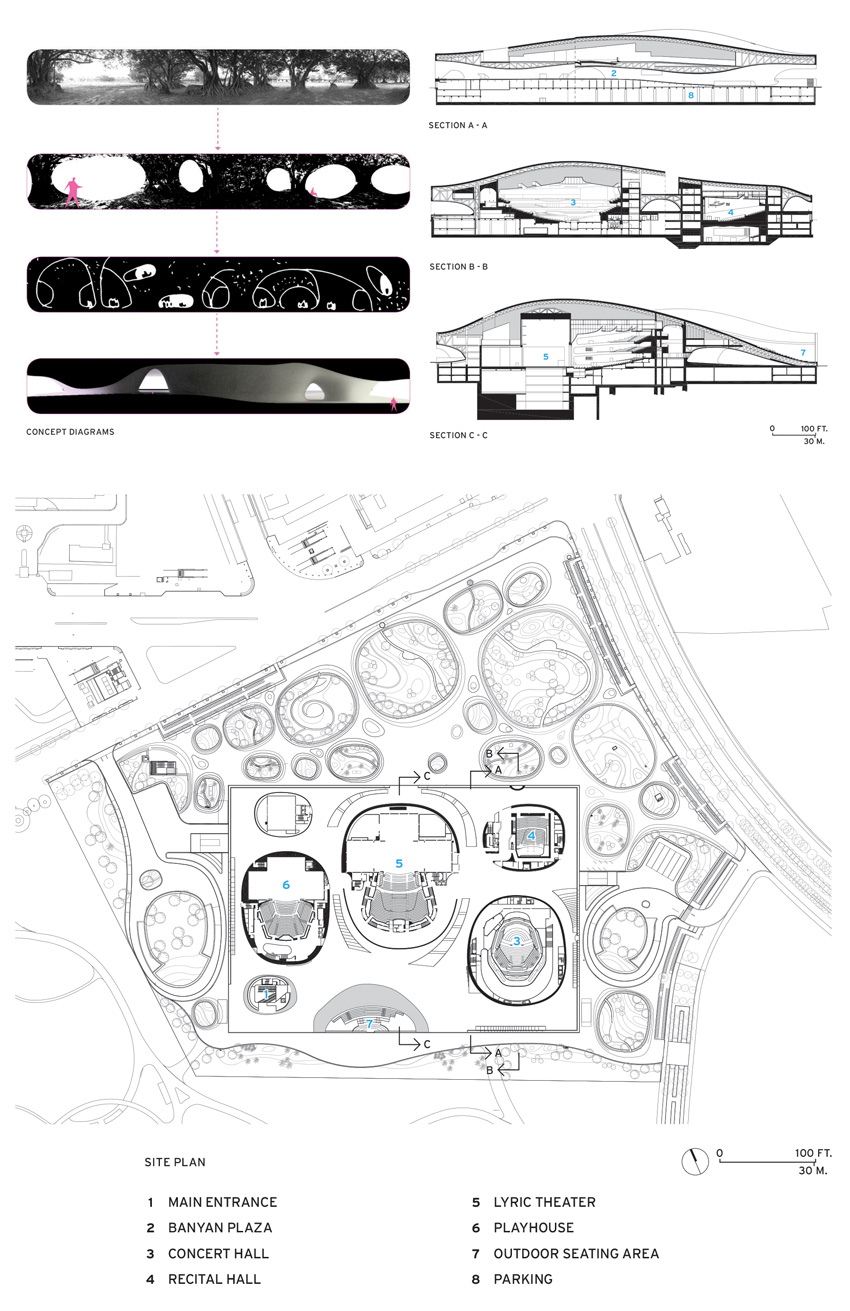
Referring to the way the building and the surrounding park merge, Chien Wen-Pin, the performance center’s artistic and executive director says, “The design demonstrates that the arts should be a seamless part of people’s lives, to be accessed without borders.” Open 24 hours a day without charge, the sinuous spaces of Banyan Plaza, many of which offer peeks into rehearsal and performance halls, underscore that message. “We want the plaza to be Kaohsiung’s living room, where anyone can come at any hour,” says Houben.
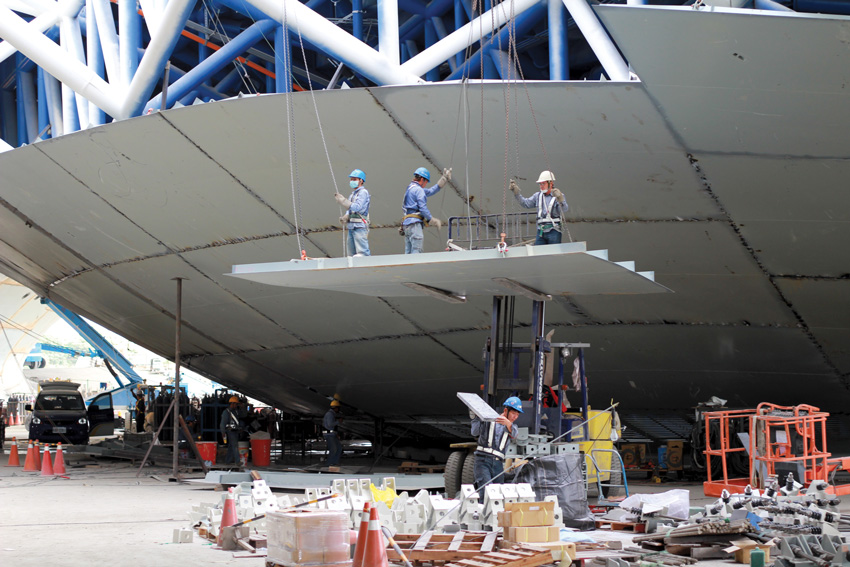
PHOTOGRAPHY: COURTESY MECANOO
IN THE WORKS
The steel panels range in size from 3⅓ by 10 feet to 13 by 20 feet; they were assembled on-site into larger modules and backed with rectangular steel stiffeners.
Called Weiwuying after the park in which it stands, the complex reflects Kaohsiung’s transformation over the past 15 years from a harbor city with a mostly industrial economy to a more diverse metropolis, where parks and cultural facilities attract well-educated Taiwanese and offer tourists a reason to visit. During the 12 years it took to design and build Weiwuying, the local and national governments have connected the city to the capital, Taipei, and to Taichung, the country’s second-largest city, via high-speed rail, and opened a subway system for Kaohsiung. The first phase of a new transit station, also designed by Mecanoo, officially opened the day after the arts center and features extensive landscaped areas and a covered public plaza that express some of the same ideas but in different form.
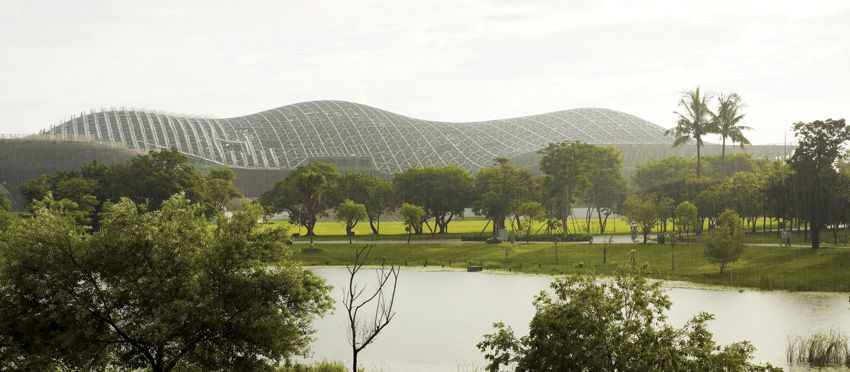
PHOTOGRAPHY: © CHRISTIAN RICHTERS
The undulating roof comprises a tubular steel space frame.
Part of a network of national performing-arts centers, this latest one joins Taipei’s National Theater and Concert Hall, which opened in 1987; the National Taichung Theater, designed by Toyo Ito, which debuted in 2016 (record, December 2016); and the Taipei Music Center, by Reiser + Umemoto, opening next year. As both a major arts center and a piece of architecture, Weiwuying serves as an element in Taiwan’s effort to assert its “soft power” as a cultural magnet in the region.
Houben calls it a “sandwich building,” with the negative space of the open plaza being as important as the enclosed elements above and below it. Visitors roaming this interstitial realm experience the complex as if it were a giant sculpture by Rachel Whiteread, the British artist who often creates concrete or plaster casts of building facades and rooms. Like Whiteread’s work, Weiwuying plays with our sense of positive and negative, constructed and leftover.
Mecanoo, however, decided to use steel plates rather than poured-in-place concrete to envelop Banyan Plaza’s curvaceous spaces and enclose the performance halls. The quarter-inch-thick plates, which acknowledge Kaohsiung’s history as a shipbuilding center, are welded together and painted a grayish white to retain the rugged look of a “cargo ship, not a yacht,” says Houben.
“We wanted a pure, ‘single’ material, not something molded by forms that are then thrown away,” says Friso van der Steen, Mecanoo’s technical director and a partner at the firm. The panels, cold-bent in shipyards in Taiwan and the Netherlands, range in size from 3⅓ by 10 feet to 13 by 20 feet and were assembled on-site into larger modules and backed with rectangular steel stiffeners. Then they were hoisted into place and welded into a continuous, seamless surface. “That’s the way ships are built, so they don’t leak,” says van der Steen.
Suspension rods and fork-shaped steel brackets connect the modules to the building’s underlying structure, which combines a tubular-steel space frame with poured-in-place concrete foundations and vertical circulation cores. Large steel springs behind the steel skin act as dampers and allow the building envelope to move independently of the structure during seismic events and storms. Using steel panels in the high-traffic public plaza also reduced maintenance issues. “They’re basically indestructible and won’t crumble or chip,” says van der Steen. Like Banyan Plaza’s skin, the building’s giant roof has no expansion joints and was designed to “float like a ship” during earthquakes, says van der Steen.

PHOTOGRAPHY: © SHAWN LIU STUDIO (LEFT) AND IWAN BAAN (RIGHT)
ALL THE WORLD'S A STAGE
One performance hall features champagne-hued oak (left). A large chunk of the roof is scooped out to provide an outdoor amphitheater (right).
Because visitors enter the performance halls from different parts of the rolling plaza, which can vary in altitude by as much as 16 feet, the architects were able to eliminate some stairs and simplify circulation. Each of the halls has its own character, with specific materials and colors, such as champagne-hued oak, maple plywood, and seat fabrics that range from opera-hall red to a bright blue. Paris-based Albert Yaying Xu served as the acoustic consultant for all of the halls, working with the architects to create the right reverberation time and sound for each one. Glass-fiber-reinforced gypsum panels on the walls and ceilings help shape the acoustics for each hall. A mechanical plant for the entire complex is placed underground to reduce noise. For the same reason, engineers specified a displacement ventilation system, with ducts in the floors supplying conditioned air at low velocities to cool the space around theatergoers. An underground story connects all of the auditoria, providing areas for moving sets and equipment, circulating people, and parking cars.

PHOTOGRAPHY: IWAN BAAN (LEFT); COURTESY NATIONAL KAOHSIUNG CENTER FOR THE ARTS (RIGHT)
In Banyan Plaza, circular chandeliers equipped with LED fixtures supplement daylight supplied by light wells (left). Film screenings on the plaza’s steel-wrapped surfaces are popular events (right).
To bring daylight into such a sprawling building, Mecanoo punched large openings into the roof above the third-floor crown that connects all the halls, and through the steel-plate enclosure above Banyan Plaza. Some of the third-floor apertures are skylights, while others create outdoor terraces where visitors can bring drinks and snacks from adjacent bars and cafés during intermissions.
By carving out a variety of spaces from the bulk of the enormous building, Mecanoo toys with our perception of scale, making the gargantuan seem accessible, even intimate in places. And the project’s visual vocabulary of fluid forms and seaworthy volumes undermines standard notions of what’s solid, what’s empty, what’s open, and what’s closed. Navigating such a complex can be challenging and requires an exploratory state of mind, but it engages users with the building in a way that will reward repeat visits.
Credits
Architect: Mecanoo — Francine Houben, partner in charge; Nuno Fontarra, project architect; Friso van der Steen, project director
Associate Architect: Archasia Design Group
Engineers: Supertech (structural); Yuan Tai (mechanical); Heng Kai (electrical)
Consultants:Xu-Acoustique (acoustics); CMA lighting (lighting); CDC (roof and facade); Theateradvies (theater)
Client: Ministry of Culture
Size: 1.51 million square feet
Cost: $366 million (total); $280 million (construction)
Completion Date: October 2018
Sources
Roofing: Bemo
Steel Skin of Banyan Plaza: CIG, Ching Fu Shipbuilding
Stage Systems: Waagner Biro
Theater Seating: Kotobuki Seating















